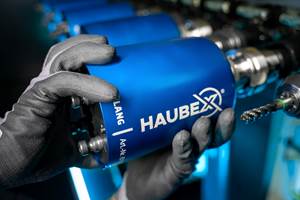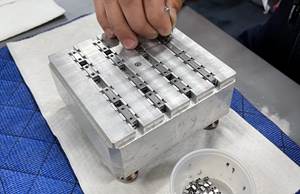Gradual Software Implementation Allows Users To Find Comfort Zone
Big shops may have the financial resources and personnel to change the way they do business almost overnight when they make changes in their information systems. However, at this small shop, that was not the approach shop management took to automation.
Big shops may have the financial resources and personnel to change the way they do business almost overnight when they make changes in their information systems. However, at 40-year-old Cullip Tool & Die (Elkhart, Indiana), a 15-employee shop, that was not the approach shop management took to automation. When John Cullip, the second generation coowner, decided the growing business required a more uptodate approach, he also decided the best way to go about making the change would be gradually.
When increased production volume prompted shop automation, Mr. Cullip recognized the need for a software vendor who not only understood the situation, but could also provide enough product support and flexibility to implement the program the way he wanted to.
"Scheduling was the main reason that we went to a computerized system. When we started running more jobs, I wanted some kind of scheduling capability to help us become more efficient as our shop grew," Mr. Cullip recalls. Cullip Tool & Die was still using the manual system put in place when the business was founded before turning to a computerized shop management system in October, 1996.
That was about the same time the shop received a sales call from Bill Rippey, a sales representative from Henning Industrial Software (Hudson, Ohio). Mr. Rippey gave the Cullips a demonstration of Henning's EstiTrack shop control program. He also mentioned that the Windows version of the program, Visual EstiTrack, was about to be released.
Mr. Cullip liked the ability to take implementation of the system at a pace shop personnel were comfortable with. With a new secretary and some other things going on in the business at the time, it was convenient to start with purchase orders. "You can put in a little bit of the system and learn to use that part of it and get comfortable with it before adding any more," he says.
Mr. Cullip says using the software has made the shop better by standardizing operations and the information available for each job. It has also ensured that the information is available at a moment's notice in a standardized format.
After the shop's employees were comfortable using the purchase orders, Mr. Cullip moved to adding shop orders to the system. "Once we got the shop orders in, we could start using the scheduling and the routers," he recalls. "Using the routers made a huge difference. Now we have a router that follows the job through the shop start to finish—showing the operations and everything done for it."
One benefit derived from the routers is the information they provide on jobs. They store instructions on particular jobs or operations. Once those instructions are in the system, they can be used every time that job comes in, according to Mr. Cullip.
In addition to the routers, the other major benefit of entering shop orders into the system was that it gave the shop the ability to use Visual EstiTrack's scheduling module. The shop uses the program's original Automatic Priority Scheduling, but plans to switch over to the more recent Drag and Drop Scheduling module when implementation of the rest of the program is finished. Mr. Cullip uses the scheduling module to place jobs on workcenters and show their schedule loads. The machine operators then make adjustments on the shopfloor based on the jobs' delivery schedules.
The shop's three primary users of Visual EstiTrack are Mr. Cullip, the plant manager and the secretary. One of Mr. Cullip's responsibilities with the program is to enter the shop's quotes into the system. His use of the estimating module is unusual because of the shop's split between tool and die work and machining.
The estimating was initially developed for machining jobs, but according to Mr. Cullip, the system is flexible enough for him to be able to adapt it to his quoting needs for tool and die work as well. He does that by using the system's setup columns to include hourly rates for die design, build, and assembly operations. On a material worksheet in the system, he enters all material costs for the job. Visual EstiTrack then brings all the prices together to form the final quote.
The only difference between his use of the software for die design and machine estimates is that the machine estimates can be used over for repeat or similar jobs. Dies are so unique that there are few times when he can reuse an old estimate.
The information for tracking jobs is put into the system by Mr. Cullip's secretary. She enters the time tickets from shop cards into the system, all sales and some purchase orders. She also uses the system to track incoming invoices and run all of the WIP reports used by the shop for billing purposes.
The plant manager does the shop's scheduling, running reports that give Mr. Cullip the shopfloor schedules and release dates. He also prints the routers and distributes them to the operators.
Another benefit of using the system has been an indirect boost in customer service, according to Mr. Cullip. "We've been averaging between 90 and 95 percent on-time delivery this year, and Visual EstiTrack is part of what helps us along with that," he says.
Related Content
Using the Toolchanger to Automate Production
Taking advantage of a feature that’s already on the machine tool, Lang’s Haubex system uses the toolchanger to move and store parts, making it an easy-to-use and cost-effective automation solution.
Read MoreInside the Premium Machine Shop Making Fasteners
AMPG can’t help but take risks — its management doesn’t know how to run machines. But these risks have enabled it to become a runaway success in its market.
Read MoreLean Approach to Automated Machine Tending Delivers Quicker Paths to Success
Almost any shop can automate at least some of its production, even in low-volume, high-mix applications. The key to getting started is finding the simplest solutions that fit your requirements. It helps to work with an automation partner that understands your needs.
Read MoreNiche Work If You Can Get It: A CNC Machine Shop Crafts Its Own Destiny
The latest innovations in metalworking aren’t always related to CNC automation or robotics. For Rosenberger North America, a 2022 Top Shops Honoree, it is the company’s niche processes that create the biggest successes.
Read MoreRead Next
3 Mistakes That Cause CNC Programs to Fail
Despite enhancements to manufacturing technology, there are still issues today that can cause programs to fail. These failures can cause lost time, scrapped parts, damaged machines and even injured operators.
Read MoreThe Cut Scene: The Finer Details of Large-Format Machining
Small details and features can have an outsized impact on large parts, such as Barbco’s collapsible utility drill head.
Read More

























